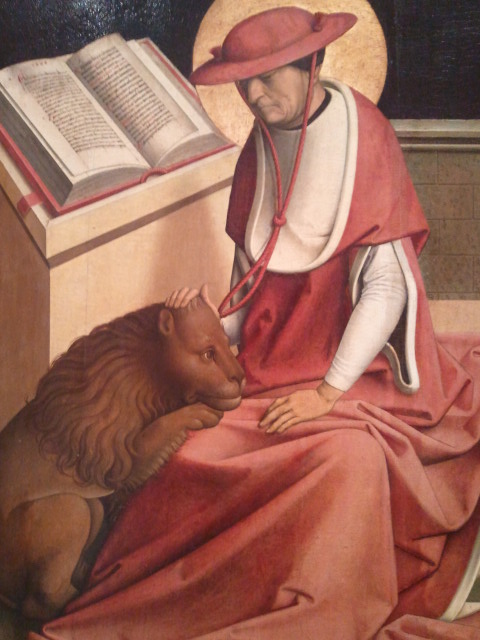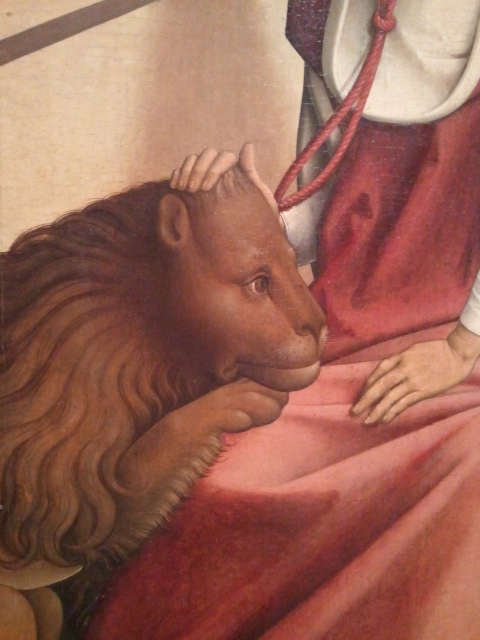On a day towards even Jerome sat with his brethren for to hear the holy lesson, and a lion came halting suddenly in to the monastery, and when the brethren saw him, anon they fled, and Jerome came against him as he should come against his guest, and then the lion showed to him his foot being hurt. Then he called his brethren, and commanded them to wash his feet and diligently to seek and search for the wound. And that done, the plant of the foot of the lion was sore hurt and pricked with a thorn. Then this holy man put thereto diligent cure, and healed him, and he abode ever after as a tame beast with them.
From “The Golden Legend ,” by Jacobus de Voragine, a medieval compilation of stories about the saints
On a recent trip to Madrid I was captivated by this painting of St. Jerome and the Lion in the Museo Thyssen-Bornemisza. Usually the lion appears as an attribute of Jerome based on a story found in the medieval bestseller, The Golden Legend. Here the lion is more than an identifier, and the saint’s relationship with the creature is the focus of the composition.
I love the artist’s gentle juxtaposition of hands and paw, expressing kindness, affection, and blessing. And I love the lion’s face, looking out into the distance as if in contemplation, with just the hint of a smile. It’s as if we are witnessing a moment of understanding between a man and his animal companion.
The story of the Jerome and the lion is interesting and multifaceted. It begins like the tale of Androcles and the lion as an example of charity overcoming fear and of kindness repaid. In this version, however, the lion is referred to as a “guest” (and thus a recipient of hospitality) who then becomes a sort of brother in the monastic community. The lion is given responsibilities reflecting his new nature and according to his abilities–he is to tend and guard the monastery donkey. When the animal is stolen while his guardian sleeps, the lion is falsely accused of having eaten it, which is to say, of not having a true conversion and yielding to the sin of gluttony. The lion is punished and shamed by being forced to take on the work of the ass, and the author notes, “he suffered it peaceably.”
Thankfully the story has a happy ending. Eventually the lion finds the stolen ass, brings it back, and is forgiven.
And then the lion began to run joyously throughout all the monastery, as he was wont to do, and kneeled down to every brother and fawned them with his tail, like as he had demanded pardon of the trespass that he had done.
How curious and fitting that the lion’s nature makes him both run joyously and demand pardon! And because of the lion’s righteous ferocity, the thieves also come before Jerome to ask pardon. The saint does not take all their valuable oil, though they offer it as penance, but tells them to “take their own good, and not to take away other men’s,” and so debts are paid, sin is forgiven, and community is restored.
Which bring us back to the painting–so different from the many other pictures of St. Jerome–a painting about more than the holiness of a saint. A painting about a saint and a lion. Surely it is no accident that hands and paw should tell this tale and bring to mind those virtues of hospitality, humility, and forgiveness present in other stories we know so well: the washing of feet, the suffering of shame, the blessings of community.




Good study of an old painting also tells fellowship
Master of Grossgmain
Saint Jerome as a Cardinal
1498
Oil on panel. 67 x 49 cm
Museo Thyssen-Bornemisza, Madrid
Your posts are always a pleasure, especially during difficult times. 🙂